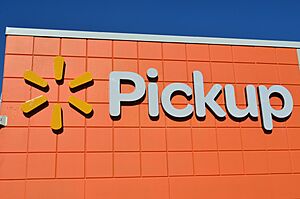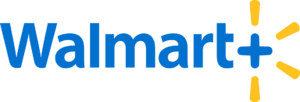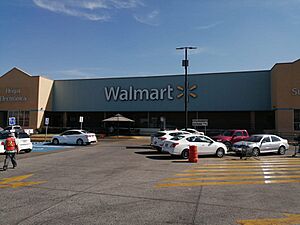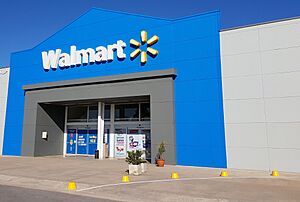Walmart facts for kids

Wordmark used since 2025
|
|

Spark symbol used since 2025
|
|
|
Formerly
|
|
|---|---|
| Public | |
| Traded as | |
| ISIN | ISIN: [https://isin.toolforge.org/?language=en&isin=US9311421039 US9311421039] |
| Industry | Retail |
| Predecessor | Walton's Five and Dime |
| Founded | July 2, 1962, in Rogers, Arkansas, U.S. |
| Founders |
|
| Headquarters |
,
United States
36°21′56″N 94°13′03″W / 36.36556°N 94.21750°W |
|
Number of locations
|
10,771 (2025) |
|
Area served
|
Worldwide |
|
Key people
|
|
| Services |
|
| Revenue | |
|
Operating income
|
|
| Total assets | |
| Total equity | |
| Owner | Walton family (44.8%) (mainly via Walton Enterprises) |
|
Number of employees
|
2,100,000 (2025) |
| Divisions |
|
| Subsidiaries | List of subsidiaries |
| Footnotes / references Financials as of January 31, 2025[update]. References: |
|
Walmart Inc. is a huge American company that runs many different types of stores. You might know them as hypermarkets (also called Supercenters), discount department stores, and grocery stores. Walmart has stores in the United States and 23 other countries. Its main office is in Bentonville, Arkansas. The company started in 1962, founded by brothers Sam Walton and James "Bud" Walton in Rogers, Arkansas. Walmart also owns and runs Sam's Club warehouses.
Walmart is the biggest company in the world based on how much money it makes, according to the Fortune Global 500 list. It's also the largest private employer globally, with 2.1 million employees. The company is mostly owned by the Walton family, with Sam Walton's family owning over half of it.
Walmart joined the New York Stock Exchange in 1972. By 1988, it was the most profitable retailer in the U.S., and by 1989, it was the largest in terms of sales. Originally, Walmart stores were mostly in the South and Midwest, but by the early 1990s, they had stores all across the country. Walmart has faced discussions about its business practices, including how it treats employees and suppliers, its environmental efforts, and how it handles safety.
Walmart's international ventures have had mixed results. Stores in Canada, the United Kingdom (ASDA), Central America, Chile (Líder), and China have been successful. However, their businesses in Germany, Japan, South Korea, Brazil, and Argentina did not work out as planned.
Contents
- Walmart's Journey: A Look at Its History
- How Walmart Operates Around the World
- Walmart's Own Brands
- Online Shopping Growth
- How Walmart is Run
- Walmart's Charity Work
- Walmart's Impact on the Economy
- Walmart and the Environment
- Environmental Risks for Walmart
- Working at Walmart
- More About Walmart
- See also
Walmart's Journey: A Look at Its History
How Walmart Began: 1945–1969


In 1945, Sam Walton, who used to work at J. C. Penney, bought a Ben Franklin store. His main idea was to sell things at very low prices. He wanted to sell a lot of items with a small profit on each, seeing it as a way to help customers. Even though his first store was expensive to set up, he found ways to get products cheaper than other stores. This allowed him to offer lower prices. Sales grew quickly, reaching $250,000 in five years. When his lease ended, he opened a new store in Bentonville, calling it "Walton's Five and Dime." This store is now The Walmart Museum.
On July 2, 1962, Walton opened the first Wal-Mart Discount City store in Rogers, Arkansas. He got the idea from other discount stores he visited. The name "Wal-Mart" was inspired by "FedMart," another discount chain. In its first five years, the company grew to 18 stores in Arkansas and made $9 million in sales. By 1968, Walmart opened its first stores outside Arkansas, in Sikeston, Missouri and Claremore, Oklahoma.
Growing Strong: 1969–1990
The company officially became Wal-Mart, Inc. on October 31, 1969, and changed its name to Wal-Mart Stores, Inc. in 1970. That same year, it opened its main office and first distribution center in Bentonville, Arkansas. It had 38 stores, 1,500 employees, and sales of $44.2 million. Walmart became a publicly traded company on October 1, 1970, and was soon listed on the New York Stock Exchange. By 1975, Walmart had 125 stores, 7,500 employees, and sales of $340.3 million, operating in Arkansas, Kansas, Louisiana, Missouri, Oklahoma, Tennessee, Kentucky, Mississippi, and Texas.
In the 1980s, Walmart tried out a new store idea called Hyper-Mart, which combined discount stores, supermarkets, and other services. Walmart continued to grow fast. By its 25th anniversary in 1987, there were 1,198 Walmart stores with sales of $15.9 billion and 200,000 employees. Walmart's success was partly due to how it expanded, building new distribution centers close to existing stores.
In 1987, the company finished building its satellite network. This $24 million investment connected all stores, allowing the main office to track inventory and sales and communicate instantly with stores. In 1988, Sam Walton stepped down as CEO, and David Glass took over. Walton remained chairman of the board. The first Wal-Mart Supercenter opened in Washington, Missouri, that year. By 1998, Walmart had become the top toy seller, beating Toys "R" Us.
Becoming a Global Giant: 1990–2005
By the late 1980s, Walmart was more profitable than its rivals Kmart and Sears. By 1990, it became the largest U.S. retailer by sales.
Before 1990, Walmart didn't have many stores on the West Coast or in the Northeast. But in July and October 1990, it opened its first stores in California and Pennsylvania. By the mid-1990s, it was the most powerful retailer in the U.S. It expanded into Mexico in 1991 and Canada in 1994. Vermont was the last U.S. state to get a Walmart store in 1995.
The company also opened stores outside North America, entering South America in 1995 with stores in Argentina and Brazil. In July 1999, Walmart expanded into Europe by buying Asda in the United Kingdom for $10 billion.
In 1997, Wal-Mart was added to the Dow Jones Industrial Average, a list of major U.S. companies.
In 1998, Walmart introduced the Neighborhood Market, a smaller store concept. By 2005, Walmart controlled about 20% of the retail grocery business.
In 2000, H. Lee Scott became Walmart's president and CEO. The company's sales grew to $165 billion. In 2002, it was named America's largest corporation on the Fortune 500 list for the first time, with sales of $219.8 billion. It has stayed near the top of this list almost every year since.
By 2005, Walmart had $312.4 billion in sales and over 6,200 stores worldwide, employing more than 1.6 million people. Its U.S. growth was so fast that most people lived within 60 miles of a Walmart store.
As Walmart grew, some people worried about its impact on local communities, especially small towns. Studies have shown mixed results. Some small towns saw their retail business drop after a Walmart opened. However, other studies suggested that local shop owners who adapted to the changes could still do well. A study in Mississippi found both good and bad effects on existing stores when a new Supercenter opened nearby.
After Hurricane Katrina in September 2005, Walmart used its strong delivery system to quickly help with the disaster. It donated $20 million, sent 1,500 truckloads of supplies, and provided food for 100,000 meals. It also promised jobs to its employees who were affected by the hurricane. An independent study found that Walmart, The Home Depot, and Lowe's were able to provide emergency supplies and reopen stores much faster than the government agency FEMA.
In 2006, Charles Fishman wrote a book called The Wal-Mart Effect, which looked at how Walmart's supply chain works. This book showed how Walmart tries to lower costs and be more efficient, which can affect many other businesses.
New Ideas and Changes: 2005–2010
Caring for the Environment

In November 2005, Walmart announced plans to become more environmentally friendly. They aimed to spend $500 million a year to make their truck fleet more fuel-efficient, reduce greenhouse gas emissions, cut energy use in stores, and reduce waste. CEO Lee Scott said Walmart wanted to be a "good steward of the environment" and eventually use only renewable energy and produce zero waste. The company also designed new experimental stores with wind turbines and photovoltaic solar panels. Walmart also became a big seller of organic milk and cotton. In 2007, Walmart even created its own electric company in Texas to save money on power and possibly sell electricity to customers later.
New Look and Slogan
In 2006, Walmart started remodeling its U.S. stores to attract more types of shoppers. They opened a new store in Plano, Texas, with high-end electronics, jewelry, expensive wines, and a sushi bar.
On September 12, 2007, Walmart introduced a new advertising slogan: "Save money. Live better.". This replaced their old slogan, "Always Low Prices, Always", which they had used since 1988. Research showed that Walmart's lower prices saved consumers billions of dollars each year.
On June 30, 2008, Walmart changed its logo. They removed the hyphen from "Wal-Mart" and replaced the star with a "Spark" symbol. The stores became known as "Walmart," while the company name remained "Wal-Mart Stores, Inc." for a while. The new logo appeared on their website in July 2008 and in U.S. stores later that year. Walmart Canada started using the new logo in early 2009.
Helping Employees and New Purchases
On March 20, 2009, Walmart announced it was giving over $933 million in bonuses to its hourly workers. This was in addition to other benefits like profit sharing and merchandise discounts. Even during a recession, Walmart had strong sales of $401.2 billion for the year ending January 31, 2009.
On February 22, 2010, Walmart bought the video streaming company Vudu, Inc. for about $100 million.
Modern Walmart: 2011–Present
Walmart's trucks travel millions of miles every year. The company aimed to make its fleet twice as efficient between 2005 and 2015. Some trucks were even changed to run on biofuel made from cooking grease from Walmart stores.
In August 2013, Walmart discussed buying a large part of Naivas, a supermarket chain in Kenya.
In 2015, Walmart became the biggest U.S. commercial producer of solar power, with many solar panels on its rooftops and over parking lots.
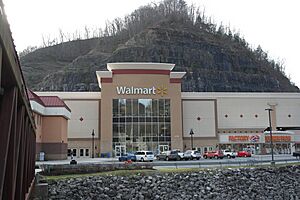
On January 15, 2016, Walmart announced it would close 269 stores globally, affecting 16,000 workers. Most of these were in the U.S., often near other Walmart stores. The company wanted to focus on its Supercenters, Neighborhood Markets, and online business. On August 8, 2016, Walmart announced it would buy the e-commerce website Jet.com for $3.3 billion to better compete with Amazon.com. Jet.com's co-founder, Marc Lore, stayed to run Walmart's U.S. online operations. On October 19, 2016, Walmart partnered with IBM and Tsinghua University to use blockchain technology to track the pork supply chain in China, aiming to save money and increase profits.
On February 15, 2017, Walmart bought Moosejaw, an online outdoor clothing and gear retailer, for about $51 million. On June 16, 2017, Walmart agreed to buy the men's clothing company Bonobos for $310 million to grow its fashion business. On September 29, 2017, Walmart acquired Parcel, a same-day delivery company in Brooklyn. In 2018, Walmart started a delivery service called "Spark," using private drivers.
On December 6, 2017, Walmart announced it would change its corporate name to Walmart Inc. from Wal-Mart Stores, Inc., starting February 1, 2018.
On January 11, 2018, Walmart announced the closure of 63 Sam's Club locations. Some of these stores became e-commerce distribution centers. On the same day, Walmart announced it would raise starting wages for its U.S. hourly workers, give bonuses, and expand leave policies due to a new tax law.
In February 2019, Walmart acquired Aspectiva, a product review startup from Tel Aviv. In May 2019, Walmart launched free one-day shipping on many items with a minimum purchase.
In September 2019, Walmart stopped selling all e-cigarettes due to "regulatory complexity." Earlier in 2019, they stopped selling fruit-flavored e-cigarettes and raised the minimum age to 21 for tobacco products. That same month, Walmart opened its first Health Center, offering primary care services at low prices. By October 2019, Walmart stopped selling all live fish and aquatic plants.
Recent Developments: 2020s
In early 2020, the coronavirus (COVID-19) pandemic led to temporary changes at Walmart, like store closures, limited customer numbers, and social distancing rules. Store hours were adjusted for cleaning and stocking, and limits were placed on some items due to panic buying.
During the pandemic, Walmart changed some employee benefits. Employees could take unpaid leave if they felt unsafe working. Those who got the virus received up to two weeks of pay. Walmart also paid $428 million in bonuses to its staff. Starting in July 2020, customers had to wear masks in all Walmart and Sam's Club stores nationwide. By February 2022, most COVID-19 restrictions, including mask rules, were lifted.
In the first quarter of 2020, Walmart's sales increased by 10.5%, and online sales rose by 74% as people bought more groceries to eat at home. In December 2020, Walmart launched a new service called Carrier Pickup for easy returns.
In January 2021, Walmart announced it was starting a fintech company with Ribbit Capital to offer financial products. In February 2021, Walmart acquired technology from Thunder Industries to improve its online advertising. In May 2021, Walmart bought Zeekit, an Israeli startup that uses artificial intelligence to let customers virtually try on clothes.
In August 2021, Walmart opened its Spark delivery service to other businesses. In June 2022, Walmart acquired Memomi, an AR optical tech company. In August 2022, Walmart announced it was buying Volt Systems, a software company for managing vendors and tracking products. Walmart also partnered with Paramount to offer Paramount+ content to its Walmart+ subscribers, competing with Amazon.
In August 2022, Walmart announced that most stores would no longer be open 24 hours, typically operating from 6 AM to 11 PM.
In January 2023, Walmart raised its minimum wage for U.S. hourly workers from $12 to $14 an hour. This raise affected about 340,000 employees, and Walmart's average U.S. wage became over $17.50. The company also added more college degrees and certificates to its Live Better U program.
In February 2023, Walmart reported $611.3 billion in sales for the previous financial year, a 6.7% increase. Profits almost doubled from the year before. In April 2023, the company announced plans to add electric vehicle charging stations at thousands of stores by 2030.
In January 2024, Walmart announced it would open over 150 new stores in the U.S. over the next five years and remodel 650 existing ones. This marked a shift from its previous focus on online competition. In February 2024, Walmart announced that its "Project Gigaton" initiative, aimed at reducing supplier emissions, reached its goal six years early.
In 2024, Walmart reported that it was removing self-checkout from some stores based on customer feedback. On August 27, 2024, Walmart announced a new service to transport goods from Asia to the U.S., aiming to compete better with Amazon. On November 25, 2024, Walmart announced it was ending its diversity, equity, and inclusion (DEI) programs and removing certain products.
In January 2025, Walmart updated its logo for the first time since 2008, making the wordmark slightly larger and the "Spark" symbol bigger with a darker blue background.
Employee Benefits and Acquisitions
In February 2024, Walmart announced that managers would receive stock grants of up to $20,000. The company also announced a 3-for-1 stock split, making it easier for employees to buy company stock. This kind of stock reward for regular employees is rare in retail.
Also in February, Walmart agreed to buy Vizio for $2.3 billion to expand its advertising sales through Vizio's streaming video content. This acquisition was finalized on December 3.
How Walmart Operates Around the World
As of 2016, Walmart's business is divided into four main parts: Walmart U.S., Walmart International, Sam's Club, and Global eCommerce. In the United States, Walmart has four store types: discount stores, Supercenters, Neighborhood Markets, and Sam's Club. Walmart International stores also include supermarkets, hypermarkets, and other specialized stores. Kathryn McLay is the president and CEO of Walmart International.
Walmart in the U.S.
-
Walmart in Fajardo, Puerto Rico
Walmart U.S. is the company's biggest part, making up 65% of its total sales in 2019. It includes Supercenters, Discount Stores, Neighborhood Markets, and other smaller stores. Discount stores sell mostly non-grocery items, but the focus has shifted to Supercenters, which offer more groceries. As of October 31, 2022, there were 4,720 Walmart U.S. stores. About 90% of people in the United States live within 10 miles of a Walmart store. John Furner is the president and CEO of Walmart U.S.
Walmart Supercenter
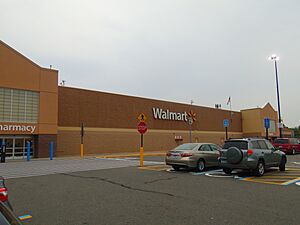
Walmart Supercenters are very large stores, usually between 69,000 and 260,000 square feet. They sell general merchandise and have a full supermarket, including fresh food, baked goods, and seafood. Many Supercenters also have a garden center, pet shop, pharmacy, and other small shops like phone stores or hair salons.
Many Walmart Supercenters have McDonald's or Subway restaurants inside. Some Canadian locations have Tim Hortons. Some U.S. locations also have Burger King, Wendy's, or Taco Bell. Some Supercenters even have gas stations.
The first Supercenter opened in Washington, Missouri, in 1988. As of October 31, 2022, there were 3,572 Walmart Supercenters in 49 U.S. states, Washington, D.C., and Puerto Rico. Hawaii is the only state without a Supercenter. The largest Supercenter in the world is in Albany, New York, covering 260,000 square feet over two floors.
A typical Supercenter sells about 120,000 different items. The "Supercenter" name is no longer used in the U.S.; these stores are now just called "Walmart." However, the name "Supercentre" is still used in Canada.
Walmart Discount Store
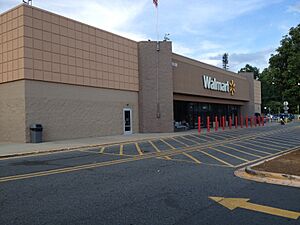
Walmart Discount Stores are also called "Walmart." They are discount department stores, usually between 30,000 and 221,000 square feet. They sell general merchandise and some groceries. Some newer or remodeled discount stores have a larger grocery section. Many of these stores also have a garden center, pharmacy, and fast food places. Some even have gas stations. Discount Stores were Walmart's original type of store, but Supercenters have become more common.
In 1990, Walmart opened "Bud's Discount City" stores, which sold closeout items. Most of these closed or became Walmart Discount Stores by 1997. At its peak in 1996, there were 1,995 Walmart Discount Stores. As of October 31, 2022, that number had dropped to 365.
Walmart Neighborhood Market
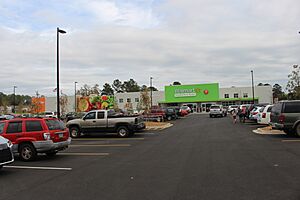
Walmart Neighborhood Market stores are smaller, usually between 28,000 and 65,000 square feet, about one-fifth the size of a Supercenter. The first Neighborhood Market opened in 1998, but Walmart started focusing on this model more in the 2010s.
These stores mainly sell groceries, along with some household items and general merchandise. They focus on groceries, pharmacy, and sometimes fuel. They offer fresh produce, deli items, baked goods, and cleaning supplies. Some stores sell wine and beer and have drive-through pharmacies. Customers can also pick up online orders at these stores.
Prices at Walmart Neighborhood Market stores are the same as at larger Supercenters. An analyst from Moody's Investors Service said Walmart's pricing gives these grocery stores an advantage over competitors like Whole Foods Market and Trader Joe's.
Neighborhood Market stores grew slowly at first, filling gaps between larger Walmart stores. By 2010, Walmart planned to expand these grocery stores faster. The "Neighborhood Market" name has also been phased out in some areas, with stores now using "Walmart Market" followed by the city name. As of October 31, 2022, there were 682 Walmart Neighborhood Markets.
Past Store Ideas
Walmart opened Supermercado de Walmart stores to serve Hispanic communities in the U.S. The first one opened in Houston in 2009. Both locations closed in 2014. In 2009, Walmart also opened "Más Club," a warehouse store similar to Sam's Club, which also closed in 2014.
Walmart Express was a chain of smaller discount stores that offered groceries, check cashing, and gas. These stores were meant for small towns or big cities where space was limited. Walmart planned to open 15 to 20 Walmart Express stores by January 2012. By September 2014, all 22 Express stores were rebranded as Neighborhood Markets. As of October 31, 2022, there were 101 small-format stores in the U.S. On January 15, 2016, Walmart announced it would close 269 stores globally, including the 102 former or planned Express stores.
From 2002 to 2022, Walmart owned the Amigo supermarkets in Puerto Rico. In 2022, Walmart sold its Amigo stores to Pueblo Inc. to focus on its larger Supercenter and Sam's Club stores there.
New Services and Programs
In September 2006, Walmart started a program to sell generic drugs for $4 per prescription. This program expanded to all Florida stores by January 2007. Walmart says it can offer these low prices because of its efficient mass distribution system. Many of these low-cost generic drugs come from India.
On February 6, 2007, the company launched a movie download service, selling about 3,000 films and TV shows. This service was stopped on December 21, 2007, due to low sales.
In 2008, Walmart tested a small grocery store concept called Marketside in the Phoenix, Arizona, area. These four stores closed in 2011.
In 2015, Walmart began testing a free grocery pickup service. Customers could order groceries online and pick them up at the store, where an employee would load them into their car. As of December 17, 2017, this service was available in 39 U.S. states.
In May 2016, Walmart changed its ShippingPass service to offer two-day delivery, similar to Amazon. Walmart priced it at $49 per year, compared to Amazon Prime's $99.
In June 2016, Walmart and Sam's Club announced they would test a grocery delivery service using companies like Uber and Lyft. Customers could order groceries online and have them delivered for a small fee. By March 14, 2018, Walmart expanded online delivery to 100 U.S. metropolitan areas.
Walmart introduced its Winemakers Selection private label wine in June 2018. This wine, from various sources, was praised for its good quality at an affordable price ($11 to $16 per bottle).
In October 2019, Walmart announced that customers in 2,000 locations could use the grocery pickup service for alcoholic beverages. Walmart also started delivering alcoholic beverages from nearly 200 stores in California and Florida.
In February 2020, Walmart announced a new membership program called "Walmart +." This news came after Walmart stopped its personal shopping service, Jetblack.
Number of Stores by State
Locations as of October 1, 2022
| State | Supercenters | Discount Stores |
Neighborhood Markets |
Amigos | Sam's Clubs |
Other Pharmacy Formats |
Total stores |
|---|---|---|---|---|---|---|---|
| Alabama | 101 | 1 | 28 | 13 | 1 | 144 | |
| Alaska | 7 | 2 | 9 | ||||
| Arizona | 84 | 2 | 26 | 12 | 124 | ||
| Arkansas | 76 | 5 | 33 | 11 | 8 | 133 | |
| California | 144 | 68 | 66 | 30 | 1 | 309 | |
| Colorado | 70 | 4 | 14 | 17 | 105 | ||
| Connecticut | 12 | 21 | 1 | 34 | |||
| Delaware | 6 | 3 | 1 | 10 | |||
| District of Columbia | 3 | 3 | |||||
| Florida | 232 | 9 | 98 | 46 | 2 | 387 | |
| Georgia | 154 | 2 | 31 | 24 | 4 | 215 | |
| Hawaii | 10 | 2 | 12 | ||||
| Idaho | 23 | 3 | 1 | 27 | |||
| Illinois | 139 | 15 | 5 | 25 | 184 | ||
| Indiana | 97 | 6 | 9 | 13 | 2 | 127 | |
| Iowa | 58 | 2 | 9 | 69 | |||
| Kansas | 58 | 2 | 14 | 9 | 83 | ||
| Kentucky | 77 | 7 | 7 | 9 | 1 | 101 | |
| Louisiana | 88 | 2 | 33 | 14 | 1 | 138 | |
| Maine | 19 | 3 | 3 | 25 | |||
| Maryland | 31 | 16 | 11 | 2 | 60 | ||
| Massachusetts | 27 | 21 | 48 | ||||
| Michigan | 90 | 3 | 23 | 1 | 117 | ||
| Minnesota | 65 | 3 | 12 | 80 | |||
| Mississippi | 65 | 3 | 10 | 7 | 1 | 86 | |
| Missouri | 112 | 9 | 16 | 19 | 156 | ||
| Montana | 14 | 2 | 16 | ||||
| Nebraska | 35 | 7 | 5 | 47 | |||
| Nevada | 30 | 2 | 11 | 7 | 50 | ||
| New Hampshire | 19 | 7 | 2 | 28 | |||
| New Jersey | 35 | 27 | 8 | 70 | |||
| New Mexico | 35 | 2 | 9 | 7 | 53 | ||
| New York | 82 | 16 | 1 | 12 | 111 | ||
| North Carolina | 143 | 6 | 43 | 22 | 214 | ||
| North Dakota | 14 | 3 | 17 | ||||
| Ohio | 138 | 5 | 27 | 170 | |||
| Oklahoma | 81 | 7 | 33 | 13 | 134 | ||
| Oregon | 29 | 7 | 9 | 45 | |||
| Pennsylvania | 116 | 20 | 24 | 160 | |||
| Puerto Rico | 13 | 5 | 11 | 7 | 36 | ||
| Rhode Island | 5 | 4 | 9 | ||||
| South Carolina | 83 | 26 | 13 | 122 | |||
| South Dakota | 15 | 2 | 17 | ||||
| Tennessee | 117 | 1 | 18 | 14 | 150 | ||
| Texas | 391 | 18 | 97 | 82 | 5 | 593 | |
| Utah | 41 | 10 | 8 | 59 | |||
| Vermont | 3 | 3 | 6 | ||||
| Virginia | 110 | 4 | 20 | 15 | 149 | ||
| Washington | 52 | 9 | 4 | 65 | |||
| West Virginia | 38 | 5 | 1 | 44 | |||
| Wisconsin | 83 | 4 | 2 | 10 | 99 | ||
| Wyoming | 12 | 2 | 14 |
Walmart Around the World
As of October 31, 2022, Walmart had 5,266 stores and 800,000 employees in 23 countries outside the United States. It fully owns operations in Argentina, Brazil, Canada, and the UK. Walmart is the largest private employer in the U.S. and Mexico, and one of the largest in Canada. In 2019, Walmart's international sales were $120.824 billion.
Central America
Walmart owns 51% of the Central American Retail Holding Company (CARHCO). As of October 31, 2022, this includes 868 stores across Guatemala, El Salvador, Honduras, Nicaragua, and Costa Rica, under various names like Paiz, Walmart Supercenter, and Despensa Familiar.
Chile
In January 2009, Walmart bought a large part of Chile's biggest grocer, Distribución y Servicio D&S SA. In 2010, it was renamed Walmart Chile. As of October 31, 2022, Walmart Chile runs about 384 stores under names like Lider and Superbodega Acuenta.
Mexico
Walmart opened its first international store in Mexico in 1991. As of October 31, 2022, Walmart's Mexico division is the largest outside the U.S., with 2,804 stores. These include Walmart Supercenter, Sam's Club, and Bodega Aurrera.
Canada
Walmart has been in Canada since 1994, when it bought 122 Woolco stores. As of October 31, 2022, it has 402 locations, including Supercentres and discount stores. Walmart Canada's first Supercentres opened in November 2006.
In 2010, Walmart Canada Bank was launched, offering the Walmart (Canada) Rewards MasterCard. However, in May 2018, Walmart Canada announced it would sell Walmart Canada Bank. This bank was later renamed Duo Bank of Canada.
Africa
On September 28, 2010, Walmart announced it would buy Massmart Holdings Ltd. in South Africa for over $4 billion. This gave Walmart its first presence in Africa. As of October 31, 2022, it has 411 stores in South Africa and other African countries like Botswana, Ghana, and Nigeria, under various store names.
China
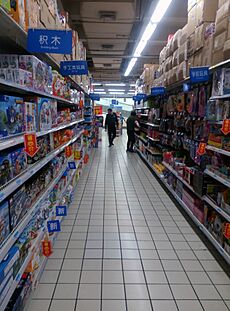
Walmart has partnerships and owns stores in China. As of October 31, 2022, Walmart China operates 369 stores, including Walmart Supercenter and Sam's Club.
In February 2012, Walmart increased its ownership in the Chinese online supermarket Yihaodian. Walmart took full ownership in July 2015. In October 2016, Walmart launched the Food Safety Collaboration Center in Beijing to improve food safety and tracking in China using blockchain technology.
India

In November 2006, Walmart announced a partnership with Bharti Enterprises to operate in India. Walmart operates wholesale stores in India called Best Price Modern Wholesale. The first store opened in Amritsar on May 30, 2009. In October 2013, Bharti and Walmart ended their partnership.
On May 9, 2018, Walmart announced it would buy a 77% share in the Indian e-commerce company Flipkart for $16 billion. This deal was completed on August 18, 2018. As of October 31, 2022, there are 28 Best Price Modern Wholesale locations.
Challenges and Changes
In the 1990s, Walmart tried to enter the German and Indonesian retail markets but faced difficulties. In Indonesia, stores closed due to the 1997 Asian financial crisis.
In Germany, Walmart bought two supermarket chains in 1997 and 1998. However, the German market was very competitive, and Walmart's low-price strategy didn't give it an advantage. Walmart's company culture was also not well-received by employees and customers. In July 2006, Walmart left Germany due to ongoing losses.
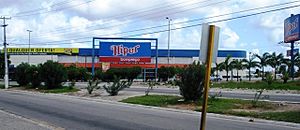
In 2004, Walmart bought 118 stores in the Bompreço supermarket chain in Brazil. By 2010, Walmart was the third-largest supermarket chain in Brazil. Since August 2018, Walmart Inc. only owns a small part of Walmart Brasil, which was renamed Grupo Big. In March 2021, Carrefour announced it would buy Grupo Big.
Walmart Argentina started in 1995. On November 6, 2020, Walmart sold its Argentine operations to Grupo de Narváez.
Walmart's UK company, Asda, is based in Leeds. Asda is mainly a grocery chain but also sells many non-food items. In 2010, Asda bought stores from Netto UK. In July 2015, Asda updated its logo to include the Walmart "Spark" symbol. In May 2018, Walmart planned to sell Asda to Sainsbury's, but this sale was blocked in April 2019.
On October 2, 2020, Walmart announced it would sell most of its share in Asda to a group of investors.
In Japan, Walmart fully owned Seiyu as of 2008. On November 16, 2020, Walmart announced it would sell 65% of its shares in Seiyu to a private-equity firm. Walmart kept 15% and a seat on the board.
Business Practices
In 2012, there were reports about a crawfish processing company in Louisiana, CJ's Seafood, that worked with Walmart. The reports said that 40 workers from Mexico were treated poorly, living in bad conditions and forced to work long hours. When workers complained, management reportedly threatened their families. Eight workers went on strike and told their stories to Walmart. After an investigation and a protest, Walmart decided to stop working with CJ's Seafood. Later, the Department of Labor fined CJ's Seafood for its abuses, and the company closed down.
Sam's Club: Bulk Shopping
Sam's Club is a chain of warehouse clubs where you can buy groceries and general merchandise, often in large quantities. These stores are usually between 32,000 and 168,000 square feet. The first Sam's Club opened in 1983 in Midwest City, Oklahoma, and was named after Sam Walton. As of October 31, 2022, Sam's Club had 600 membership warehouse clubs and made up 11.3% of Walmart's sales in 2019. Christopher Nicholas is the president and CEO of Sam's Club.
Global Online Shopping
Walmart's Global eCommerce division is based in San Bruno, California. It handles online sales for Walmart, Sam's Club, Asda, and other international brands. It has offices in California, Oregon, Shanghai (China), Leeds (United Kingdom), and Bangalore (India).
Walmart's Own Brands
About 40% of the products sold at Walmart are its own private label brands. These products are made for Walmart by other manufacturers. Walmart started offering its own brands in 1991 with Sam's Choice, a line of drinks. Sam's Choice quickly became very popular. Other Walmart brands include Great Value and Equate in the U.S. and Canada, and Smart Price in Britain.
Online Shopping Growth
Walmart's online marketplace started in 2009 but became more active in 2016 when Walmart bought the e-commerce company Jet.com. Jet.com had also acquired other online retailers like Hayneedle and Shoebuy.com. Walmart also bought Parcel, a delivery service in New York, in 2017.
On February 15, 2017, Walmart acquired Moosejaw, an online outdoor retailer, for about $51 million. Moosejaw had partnerships with over 400 brands like Patagonia and The North Face.
Marc Lore, Walmart's U.S. e-commerce CEO, said that Walmart's many physical stores could also act as warehouses for online orders, helping their digital growth without adding much cost. As of 2017, Walmart offered in-store pickup for online orders at 1,000 stores, with plans to expand this service.
On May 9, 2018, Walmart announced its plan to buy a 77% share in the Indian e-commerce website Flipkart for $16 billion. This deal was completed on August 18, 2018.
On May 19, 2020, Walmart announced it was closing Jet.com, directing all visitors to the Walmart website instead.
How Walmart is Run
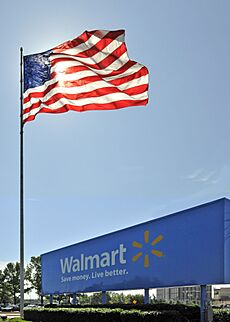
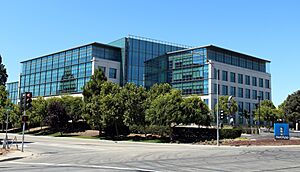
Walmart's main office is in Bentonville, Arkansas. In 2025, Walmart closed several U.S. offices and brought its corporate employees together in Bentonville or its West Coast offices in Sunnyvale, California.
Walmart's business idea is to sell a wide range of products at low prices. Doug McMillon became Walmart's CEO on February 1, 2014. He used to lead Sam's Club and Walmart International. The company calls its employees "associates." All Walmart stores in the U.S. and Canada have "greeters" at the entrance, a practice started by Sam Walton. Greeters help shoppers find what they need.
For many years, employees wore blue vests. In 2007, this changed to khaki pants and polo shirts. In 2014, vests were brought back (paid for by the company) over the polo shirts and pants. The vests are navy blue for Supercenter and discount store employees, lime green for Neighborhood Market employees, and yellow for self-checkout associates, door greeters, and customer service managers. The vests say "Proud Walmart Associate" and have the "Spark" logo. The vests were brought back because customers had trouble finding employees.
Unlike many other retailers, Walmart does not charge suppliers a fee for their products to be placed in the store. Instead, it focuses on selling popular products and encourages store managers to remove unpopular ones.
From 2006 to 2010, Walmart stopped its layaway program, but it brought it back in 2011.
Walmart started its Site-To-Store program in 2007. This program allows customers to buy items online with free shipping and pick them up at their nearest store.
On September 15, 2017, Walmart announced it would build a new headquarters in Bentonville to replace its old building and bring all its operations together.
Business Trends
For the fiscal year ending January 31, 2019, Walmart reported $6.6 billion in profit from $514 billion in sales. Its international operations made up $120 billion of its sales. Walmart is one of the world's largest public companies by revenue.
The key trends for Walmart are (as of the financial year ending January 31):
| Year | Revenue | Net Income | Total Assets | Employees |
Stores | Sources |
|---|---|---|---|---|---|---|
| US$ millions | ||||||
| 1968 | 12.6 | 0.48 | 24 | |||
| 1969 | 21.3 | 0.60 | 27 | |||
| 1970 | 30.8 | 1.1 | 1,000 | 32 | ||
| 1971 | 44.2 | 1.6 | 15.3 | 1,500 | 38 | |
| 1972 | 78.0 | 2.9 | 28.4 | 2,300 | 51 | |
| 1973 | 124 | 4.5 | 46.2 | 3,500 | 66 | |
| 1974 | 167 | 6.1 | 60.1 | 4,400 | 78 | |
| 1975 | 236 | 6.3 | 75.2 | 5,800 | 104 | |
| 1976 | 340 | 11.5 | 125 | 7,500 | 125 | |
| 1977 | 478 | 16.5 | 168 | 10,000 | 153 | |
| 1978 | 678 | 21.8 | 251 | 14,700 | 195 | |
| 1979 | 900 | 29.4 | 324 | 17,500 | 229 | |
| 1980 | 1,248 | 41.1 | 457 | 21,000 | 276 | |
| 1981 | 1,643 | 55.6 | 592 | 27,000 | 330 | |
| 1982 | 2,444 | 82.7 | 937 | 41,000 | 491 | |
| 1983 | 3,376 | 124 | 1,187 | 46,000 | 551 | |
| 1984 | 4,666 | 196 | 1,652 | 62,000 | 645 | |
| 1985 | 6,400 | 270 | 2,205 | 81,000 | 758 | |
| 1986 | 8,451 | 327 | 3,103 | 104,000 | 887 | |
| 1987 | 11,909 | 450 | 4,049 | 141,000 | 1,037 | |
| 1988 | 15,959 | 627 | 5,131 | 183,000 | 1,215 | |
| 1989 | 20,649 | 837 | 6,359 | 223,000 | 1,381 | |
| US$ billions | ||||||
| 1990 | 25.8 | 1.0 | 8.1 | 275,000 | 1,528 | |
| 1991 | 32.6 | 1.2 | 11.3 | 328,000 | 1,725 | |
| 1992 | 43.8 | 1.6 | 15.4 | 371,000 | 1,930 | |
| 1993 | 55.4 | 1.9 | 20.5 | 434,000 | 2,136 | |
| 1994 | 67.3 | 2.3 | 26.4 | 528,000 | 2,463 | |
| 1995 | 82.4 | 2.6 | 32.8 | 622,000 | 2,872 | |
| 1996 | 93.6 | 2.7 | 37.5 | 675,000 | 3,106 | |
| 1997 | 104 | 3.0 | 39.6 | 728,000 | 3,117 | |
| 1998 | 117 | 3.5 | 45.3 | 825,000 | 3,406 | |
| 1999 | 137 | 4.4 | 49.9 | 910,000 | 3,600 | |
| 2000 | 165 | 5.3 | 70.3 | 1,140,000 | 3,662 | |
| 2001 | 191 | 6.2 | 78.1 | 1,244,000 | 4,189 | |
| 2002 | 204 | 6.5 | 81.5 | 1,383,000 | 4,414 | |
| 2003 | 229 | 7.9 | 92.9 | 1,400,000 | 4,688 | |
| 2004 | 256 | 9.0 | 104 | 1,500,000 | 4,906 | |
| 2005 | 284 | 10.2 | 120 | 1,700,000 | 5,289 | |
| 2006 | 312 | 11.2 | 138 | 1,800,000 | 6,141 | |
| 2007 | 348 | 11.2 | 151 | 1,900,000 | 6,779 | |
| 2008 | 377 | 12.7 | 163 | 2,100,000 | 7,262 | |
| 2009 | 404 | 13.3 | 163 | 2,100,000 | 7,870 | |
| 2010 | 408 | 14.3 | 170 | 2,100,000 | 8,416 | |
| 2011 | 421 | 16.3 | 180 | 2,100,000 | 8,970 | |
| 2012 | 446 | 15.6 | 193 | 2,200,000 | 10,130 | |
| 2013 | 468 | 16.9 | 203 | 2,200,000 | 10,773 | |
| 2014 | 476 | 16.0 | 204 | 2,200,000 | 10,942 | |
| 2015 | 485 | 16.3 | 203 | 2,200,000 | 11,453 | |
| 2016 | 482 | 14.6 | 199 | 2,300,000 | 11,528 | |
| 2017 | 485 | 13.6 | 198 | 2,300,000 | 11,695 | |
| 2018 | 500 | 9.8 | 204 | 2,300,000 | 11,718 | |
| 2019 | 514 | 6.6 | 219 | 2,200,000 | 11,361 | |
| 2020 | 523 | 14.8 | 236 | 2,200,000 | 11,501 | |
| 2021 | 559 | 13.5 | 252 | 2,300,000 | 11,443 | |
| 2022 | 572 | 13.6 | 244 | 2,300,000 | 10,593 | |
| 2023 | 611 | 11.6 | 243 | 2,100,000 | 10,623 | |
| 2024 | 648 | 15.5 | 252 | 2,100,000 | 10,616 | |
| 2025 | 674 | 19.4 | 260 | 2,100,000 | 10,771 | |
Who Runs Walmart?
Walmart is managed by an eleven-member board of directors, chosen by shareholders each year. Gregory B. Penner, Sam Walton's grandson-in-law, is the chairman of the board. Doug McMillon is the president and CEO.
Some important past board members include Hillary Clinton (1985–1992).
Who Owns Walmart?
Walmart Inc. is a company registered in Delaware. As of March 2017, it had over 3.2 billion shares. These shares are mainly owned by the Walton family and large investment groups. The Walton family owns about 43% of the company through Walton Enterprises.
Competing in the Market
In North America, Walmart competes with grocery stores and department stores like Target, Kroger, and Aldi. Sam's Club competes with Costco and BJ's Wholesale Club. When Walmart started selling groceries in the late 1990s, it competed with major supermarket chains. Studies often show that Walmart's prices are much lower than its competitors.
While some believe Walmart harms small businesses, research suggests that Walmart Supercenters have little effect on smaller "Mom and Pop" stores. The impact depends on the types of goods sold. Small stores that specialize in certain products can compete well against Walmart.
Walmart also faced tough competition in other countries. In Germany, it only had a small share of the food market and left in 2006. In May 2006, Walmart sold all its stores in South Korea to a local retailer. Walmart learned to adapt its strategies in different countries, like in China, where stores started displaying live fish and seafood because customers preferred to choose their own.
Walmart's Customers
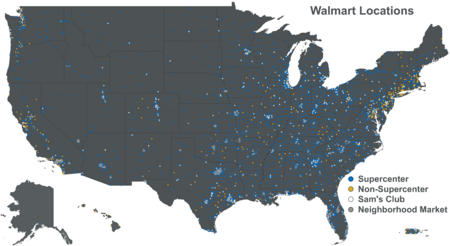
In the U.S., Walmart first grew in the Southeast and Midwest, then expanded across the country. Walmart customers are very loyal, and they say low prices are the main reason they shop there. Walmart describes its shoppers in three groups: "value-price shoppers" (who like low prices), "brand aspirationals" (who buy well-known brands for quality), and "price-sensitive affluents" (wealthier shoppers looking for deals). As of 2022, the average U.S. Walmart customer earned about $80,000 per year. During times of rising prices, more upper-income shoppers also look for bargains at Walmart.
Walmart has a history of adapting its services to its customers. In 2006, Walmart started changing its U.S. stores to fit six different customer groups, including African-Americans, Hispanic people, and suburban residents. Around six months later, it introduced a new slogan: "Saving people money so they can live better lives."
Selling Guns and Ammunition
Walmart stopped selling handguns in all U.S. states except Alaska in 1993. In 2018, Walmart stopped selling guns and ammunition to people under 21, and also stopped selling military-style rifles often used in mass shootings.
As of 2019, Walmart was a major seller of firearms and ammunition. After a mass shooting at a Walmart store in El Paso, Texas, in 2019, Walmart announced it would stop selling all handgun ammunition and certain rifle ammunition. The company also stopped selling handguns in Alaska. Walmart also asked customers not to openly carry weapons in its stores, unless they were authorized law enforcement officers.
Following a police shooting in October 2020, Walmart temporarily removed gun and ammunition displays from sales floors in thousands of U.S. stores due to concerns about civil unrest. These items were still available for purchase upon request.
Technology at Walmart
Open Source Software
Many of Walmart's technology projects are open source, meaning their code is available for others to use and improve. You can find them on the Walmart Labs GitHub page. For example, the Electrode project, which powers walmart.com, was created this way.
Using Data to Improve Shopping
As the largest retailer in the U.S., Walmart collects and analyzes a lot of customer data. This "big data" is used to predict what customers will buy, helping the company run its operations more efficiently. Walmart's data center is sometimes called Area 71.
In April 2011, Walmart bought Kosmix to develop software that analyzes real-time data. In August 2012, Walmart launched its Polaris search engine. The large amount of data collected by Walmart has raised some privacy concerns.
Automating Cash Handling
In 2016, Walmart began using machines to automate much of its cash handling. These machines count bills and coins quickly, allowing cashiers to process money for electronic deposits.
Walmart's Charity Work
Sam Walton believed that Walmart's main contribution to society was providing low prices, which helped customers save money. However, after Sam Walton's death in 1992, Walmart and the Walmart Foundation greatly increased their charitable giving. For example, in 2005, Walmart donated $20 million in cash and supplies for Hurricane Katrina relief. In 2020, they gave $25 million to organizations helping with the COVID-19 pandemic response. Today, Walmart donates nearly $1 billion each year to charity.
COVID-19 Response
As of January 2021, healthcare workers could get vaccines through Walmart in New Mexico and Arkansas. Walmart planned to offer vaccines in many other states, aiming to deliver millions of doses per month.
In May 2021, Walmart announced that fully vaccinated employees could stop wearing masks at work, following guidance from the U.S. Centers for Disease Control and Prevention.
Walmart's Impact on the Economy
How Walmart Helps Customers
A 2005 report said that Walmart's low food prices save American shoppers at least $50 billion each year. A study at Massachusetts Institute of Technology (MIT) in 2005 found that the poorest people benefit the most from discount stores like Walmart. In 2006, columnist George Will stated that Walmart saves shoppers over $200 billion a year.
Effects on Other Stores
Kenneth Stone, an economics professor, found that some small towns could lose almost half of their retail business within ten years of a Walmart opening. However, he also noted that shop owners who adapt to changes in the retail market can still do well. A later study found that opening a Walmart had a bigger impact on existing stores in rural areas than in urban ones.
Studies often focus on Supercenters. They suggest that supermarkets and other large stores competing directly with Walmart Supercenters see their profits decrease. While Walmart is sometimes said to harm small businesses, research suggests that Walmart Supercenters have little effect on very small "Mom and Pop" stores.
The impact seems to depend on what goods are sold. Stores that specialize in a particular product area can compete effectively against Walmart.
Effects on Jobs
A 2022 review of studies found that there is no clear agreement on Walmart's impact on local jobs, but most studies suggest a small increase in retail jobs. For example, studies found that a new Walmart store could increase retail jobs in a county by 100 in the short term, though some of these jobs might disappear over five years as other stores close.
Walmart, like other large chains, tends to hire local employees for jobs that pay lower wages and offer fewer benefits. This can sometimes mean employees rely more on public assistance programs. Studies on wages in areas where Walmart opens have mixed results; some show lower wages, while others show no effect or even an increase.
In broader economic terms, one estimate suggested that between 2001 and 2006, Walmart's trade with China led to a loss of nearly 200,000 U.S. jobs, mostly in manufacturing.
In 2014, Walmart pledged to buy $250 billion worth of American-made products over the next decade. Between 2014 and 2017, the Walmart U.S. Manufacturing Innovation Fund gave $10 million in grants to help improve domestic manufacturing. For the 2020 fiscal year, Walmart reported that almost two-thirds of its products were made, assembled, or grown in the United States. As of March 2021, Walmart promised to buy an additional $350 billion worth of American-made items over the next decade.
Effects on Efficiency
A 2001 study found that Walmart directly and indirectly caused most of the improvement in how efficiently general merchandise stores operated between 1995 and 2000. Walmart's smart use of technology, especially in managing its supply chain, is a big reason for its impact on efficiency. For every dollar Walmart spent on its own technology, its suppliers invested about ten dollars in their own systems.
Walmart and the Environment
Walmart's transportation network contributes significantly to its carbon footprint. In 2023, emissions from transportation fuel increased by 10%.
Another environmental concern is the refrigerators Walmart uses for transporting goods. These rely on gases like hydrofluorocarbons (HFCs), which are strong greenhouse gases. In 2023, emissions from refrigerants increased by 5.3% due to leaks. Walmart's shipping operations in 2021 also produced a lot of greenhouse gases, showing the environmental cost of its logistics. Walmart has faced criticism for contributing to deforestation, especially in areas that produce palm oil, soy, and beef. The company's focus on low-cost goods that don't last long also adds to landfill waste.
Environmental Risks for Walmart
Climate change creates big risks for Walmart's business. Extreme weather events like hurricanes and wildfires can cause stores to close, products to be lost, and supply chains to be disrupted. In 2017, Hurricane Harvey forced Walmart to close over 134 stores in the U.S., causing delays in deliveries. Walmart responded by using emergency systems and smart planning to restock essential items. This experience showed Walmart how important it is to have plans for adapting to climate change. The company has since included these plans in its business model. As climate disruptions are expected to increase, Walmart started "Project Gigaton." This project aims to reduce greenhouse gases and focus on energy use, nature, waste, packaging, transportation, and product design.
Working at Walmart
With over 2.3 million employees worldwide, Walmart has faced many discussions about its workforce. These include concerns about wages, working conditions, and the company's strong policies against unions. Some critics point to Walmart's high employee turnover rate (about 70% of employees leave within the first year) as a sign of an unhappy workforce, though other reasons might also be involved.
Walmart is the largest private employer in the United States, with 1.6 million employees. It employs more African Americans than any other private employer in the U.S. While some retail workers belong to unions, Walmart does not employ unionized labor and actively discourages unionization.
In March 2019, Walmart renamed its Associate Education Benefits to Live Better U. This program helps employees with their education, offering a $1-a-day college program, free high school education, and discounts on higher education through a partnership with Guild Education.
In April 2019, Walmart announced plans to use more robots in stores to help with inventory, clean floors, and unload trucks. This is part of the company's effort to lower labor costs. In June 2019, Walmart expanded its education benefits to attract high school students, offering flexible work schedules, free test prep, and debt-free college degrees in certain fields.
Fairness for Employees
In 2007, a gender discrimination lawsuit, Dukes v. Wal-Mart Stores, Inc., was filed against Walmart. It claimed that female employees were treated unfairly in pay and promotions. This case aimed to be a very large class action suit, covering 1.5 million past and current employees. On June 20, 2011, the U.S. Supreme Court ruled in Walmart's favor, saying that the plaintiffs did not have enough in common to be a class. Several plaintiffs later planned to file individual lawsuits. In 2020, Walmart agreed to pay $20 million and make other changes to settle a lawsuit about sex-based hiring discrimination.
In 2001, a consultant for the lawsuit found that female employees made up 65% of Walmart's hourly workforce but only 33% of its management. Walmart said its employee classifications were different from other retailers.
Supporting All Employees
In the Human Rights Campaign's (HRC) 2002 Corporate Equality Index, which measures how companies treat LGBT employees and customers, Walmart scored 14%. By 2017, Walmart's score had risen to 100%. In 2003, Walmart added sexual orientation to its anti-discrimination policy. In 2005, Walmart's definition of family began to include same-sex partners. In 2006, Walmart announced that its diversity efforts included new groups for minority, female, and gay employees to advise the company. In 2011, Walmart added gender identity to its anti-discrimination policy. Walmart's policies allow employees to use restrooms that match their gender identity. In 2013, Walmart started offering health insurance benefits to domestic partners. In 2015, Doug McMillon, Walmart's CEO, spoke out against a bill in Arkansas that would allow discrimination. In 2016, Walmart began offering full healthcare benefits to its transgender employees.
More About Walmart
- Big-box store
- Lukas Walton
- Walmart greeter
- Wal-Mart: The High Cost of Low Price – a 2005 movie about Walmart
- Walmarting – a new word sometimes used to describe shopping at Walmart
See also
 In Spanish: Walmart para niños
In Spanish: Walmart para niños








